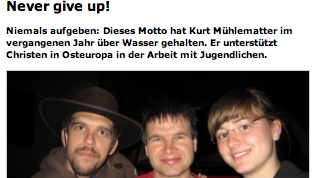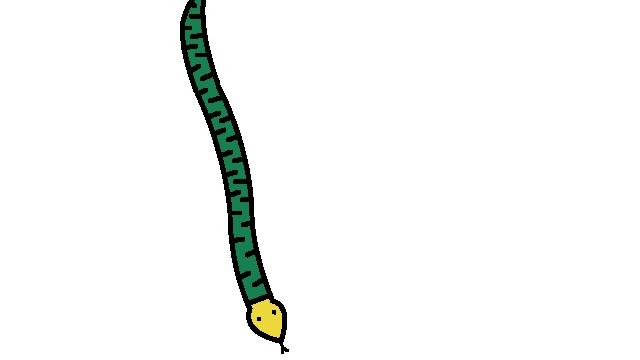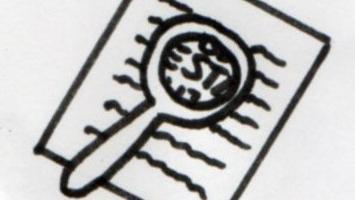This is how good newspaper articles are made:
A good public image builds trust and gives valuable relationships. Writing for newspapers can be done by those who have basic knowledge of spelling, grammar and sentence structure. This article will give you some valuable tips.
Thoughts in advance:
- Does the chosen topic have news value? Does the later reader get something out of it, derive some benefit from it? What is the special, the unusual?
- What is the goal of your article? Who do we want to appeal to? Who is the readership?
- What is it für a newspaper (regional, youth magazine, ...)
- Does the topic fit with the goals of BESJ resp. the local church and their positioning?
- Do you still need additional information to prepare the topic interesting and factual?
Contents
- Does the text content build on each other logically? Are the explanations correct, are the facts and factual arguments chosen correctly? Is the information valid and can it stand up to external scrutiny?
- Have you chosen an interesting lead? Only a good lead creates the incentive to read on.
- Does the press release contain all the necessary information? Think of the classic w’s (Who? How? Where? What? Why?).
- Are you working with quotes? Good quotes personalize a press release and bring it to life if they have a high message value.
- What societal benefits of Jesus-centered, experiential children's and youth ministry could you pick up on in your article? (See below for examples!)
- Don't forget the place and date at the beginning of the text. Are the date and place given correctly?
- Are the addressee and sender of the press release and contact details correct and fully identifiable?
- The basis of a journalistic text is actuality and importance. At the center is correctness. The primary task of the newspaper article is to convey information.
Outline
- Does the press release have an exciting headline (überschrift), which generates attention and is original?
- Is a subheadline necessary, for example, to clearly express the factual message once again?
- Do you work with structured and logical intermediate headlines, especially for long press releases?
- Put the most important things at the beginning, answer W-questions (Who? What? When? Where? How? Why?) in the first paragraph. Most of the time, editors shorten the text from the end.
- Is the äs overall impression professional and clean?
- Does the length of the press release match the content statement? There is nothing worse than unnecessary redundancies, repetitions or rhetorical blunders. Note: A press release is only in very rare cases two pages long.
Style and language
- Avoid evaluations, superlatives, flowery paraphrases, nominal style, and omit wordiness and self-understandings.
- Write actively, use little passive voice. (e.g. „The BESJ is organizing the event“ is better than „The event is being organized by the BESJ“.)
- Do not write in the first person or we form, but as it appears in the paper (e.g., The BESJ's unreached project was a resounding success…).
- Mark opinions as quotes.
- Keep text as concise as possible, but as detailed as necessary. Adhere to news style: many facts in a few short sentences.
- Break down abbreviations when they first appear in the text.
- Replace English terms and jargon with good German. Explain facts as simply as possible.
- Try to get as close as possible to the language of the journalists. Avoid too strong self-promotional statements.
- Do not write „today“ or „yesterday“ but insert the appropriate date.
Format
- One (to a maximum of two) A4 pages
- Simple typeface, 1.5 lines
- Who proofreads before the press release goes out? Always work according to the four-eyes principle!
Contact details
- Both at the end of the text and on any photos provided.
- Call contact person with telephone number and e-mail address.
Pictures
- Select photos with as muchaction and life (games, abseiling, on rope bridges…) as possible.
- Highlight special things (big projects, special food, …).
- Produce resolution: min. 300 dpi, format: jpg, eps or tif file).
- Do not choose too detailed cutouts to leave room for editing.
- Make photos available for download on the Internet.
- Attention to data protection and copyrights, ask the pictured persons whether they agree to a publication (especially important for children, but also for others)
Shipping
- What media is appropriate (local, regional)? Make a list of newspapers in your area. You can find the addresses in the respective newspapers and also on the internet – don't forget your village paper J.
- Are you sure that your distribution list is still up to date? If not, better check again. Especially pay attention to mailings!
- Be aware of deadlines: When is the deadline? Invite the press in time.
When sending by e-mail, a few special rules apply:
- Send the mail in text format (txt) and not in HTML format.
- Work with shorter texts. For longer texts, enclose the text in the attachment.
- Avoid attachments if possible, otherwise your mail will quickly end up in the SPAM filter
- Send your mails individually and personalized. Address the editor individually. If you do use a mail list, then always über the BCC field (invisible). Are your email addresses up to date?
- Don't annoy editors with Rückfragen whether the mail has arrived!
- Also put links to further information on your homepage like interviews, background info, pictures and graphics
- Keep file attachments small or make them available for download via a link
BESJ specific
- Submit the submitted article to BESJ as well – whether it appears or not.
- Mention BESJ in the text and write out the abbreviation „BESJ“ the first time (Bund Evangelischer Schweizer Jungscharen).
- Short BESJ-Porträt with the most important key data für BESJ-Info-Kästchen mitliefern:
The BESJ (Bund Evangelischer Schweizer Jungscharen) is the specialized agency for Christ-centered, experience-oriented children's and youth work. At present, about 300 national and free churches are affiliated with it. With almost 17,000 participants, it is one of the four largest youth associations in Switzerland. The BESJ works in the four areas Ameisli (6-9 yährige), Jungschi (9-13 yährige), Teenies (13-16 yährige) and Sport (6-16 yährige).
More info: www.besj.ch
Source attribution
- Title image: Juropa, www.juropa.net
- Content "BESJ-specific": Adrian Jaggi, www.besj.ch
Content may be automatically translated. Help improve the quality of the translation with your editing!



